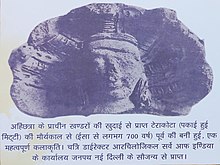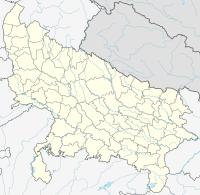Ahichchhatra Jain temples
| Ahichchhatra Jain temples | |
|---|---|
 Shri Ahichchhatra Parshvanath Atishaya Kshetra Digamber Jain Mandir | |
| Religion | |
| Affiliation | Jainism |
| Sect | Digambara and Śvētāmbara |
| Deity | Parshvanatha |
| Festivals | Mahavir Jayanti, Ahichhatra Jain Mela |
| Location | |
| Location | Ahichchhatra, Bareilly, Uttar Pradesh |
| Geographic coordinates | 28°22′23″N 79°07′06″E / 28.37306°N 79.11833°E |
| Architecture | |
| Creator | King Vasupal |
| Temple(s) | 7 |
The Ahichchhatra Jain temples is a group of Jain temples in Ahichchhatra village in Aonla tehsil of Bareilly district in Uttar Pradesh, North India. Ahichchhatra is believed to be the place where Parshvanatha, the 23rd Tirthankar of Jainism, attained Kevala Jnana.
Jain tradition
[edit]
The history of Ahichchhatra traditionally starts from the period of Rishabhanatha, the first tirthankara. According to Digambara belief, it was visited by all 24 Tirthankaras. Ahichchhatra is believed to be the place where Parshvanatha, the 23rd Tirthankar of Jainism, attained Kevala gyana (omniscience).[1] According to Jain texts, it was visited by Parshvanatha during vihara; in an attempt to obstruct Parshvanatha from achieving Kevala Jnana, Kamath, his elder brother, caused continuous rain. Parshvanatha was immersed in water up to his neck but was protected by the serpent God Dharanendra, who held a canopy of a thousand hoods over his head, and the Goddess Padmavati who coiled herself around his body. Following this event, the place was renamed to Ahichchhatra (transl. Serpent umbrella).[2][3][1]
History
[edit]Ahichchhatra was one of the sixteen Mahajanapadas.[4] It was considered an important town when Hiuen Tsang visited India in the 7th century CE.[5] Several ancient Jain āyāgapaṭa were excavated from this site, including the famous Nāṃdighoṣa āyāgapaṭa dated early c. 15 CE.[6][7][8] 27 Jain inscriptions discovered here bear dates prior to 100 CE.[9]
Alois Anton Führer excavated a Jain temple constructed during the reign of Indo-Scythians dynasty, enhrining idols from 96—152 CE.[10] A number of Jain temples were discovered by Alexander Cunningham during excavation.[11] Many idols, stupas and pillars from the Kushan and Gupta periods have been discovered in Ahichchhatra.[12]
Vividha Tirtha Kalpa, composed by Śvetāmbara Acharya Jinaprabha Suri in the 14th century CE, mentions Samkhyāvatǐ as the earlier name of Ahichchhatra and describes two Jain temples dedicated to Parshvanatha in the area.[13] According to Ahicchatra-nagri-kalpa, this place was visited by Goddess Ambika.[14] Kaivalyamala, written by Śvetāmbara Jain acharya Udyotansuri in c. 778 CE,[15][16] mentions that Harigupta of the Gupta Empire took diksha here.[12][17]
Temples
[edit]

The temples in Ahichchhatra were built to commemorate Parshvanatha attaining Kēvalajñāna kalyāṇaka.[18][1][19]
- Digambara Jain temple
The Digambara Jain temple was initially constructed during the reign of King Vasupal. The temple was later reconstructed in 1975. The temple contains 7 vedis, one of which has a 6-foot (1.8 m) idol of Mahavira while others house idols of Parshvanatha in different postures. The main idol of the temple dates back to the 10th century and is popularly known as Tikhal wale Baba.[12]
This temple, dedicated to Parshvanatha, is a major Jain pilgrimage center.[20][21] According to Uttar Pradesh Tourism, over 436,000 people visited Ahichchhatra Jain Temple in 2019.[22]
- Tis Chaubisi temple
The Tis Chaubisi temple was constructed in 2002 CE. The temple houses 720 idols of the 24 Tirthankaras. The mulnayak of this temple is a 13.5-foot (4.1 m) idol of Parshvanatha.[12]
- Bhagwan Parshvanath-Padmavati temple
The Bhagwan Parshvanath-Padmavati temple was constructed in 2007 CE. The temple houses an idol of Parshvanatha in the centre with idols of Dharanendra and Padmavati on either side.[12]
- Chaubisi temple
The Chaubisi temple is built beside the old Digambara Jain temple in an area spanning 17,500 square metres (188,000 sq ft).[12]
- Shwetambar Jain temple
The Shwetambar temple is a beautiful structure known for its unique architecture. The temple is made of buff sandstone and houses a thousand images of the Jain pantheon.[12]
Both Digambara and Shwetambar Jain temple also have a dharamshala equipped with all modern facilities and bhojnalaya.[12]
Fair
[edit]Ahichchhatra Jain Mela is the primary festival of this temple and is organized annually in March.[21]
Gallery
[edit]-
Bhagwan Parshvanath-Padmavati temple
-
Tis Chaubisi temple
-
Ahichchhatra ancient village temple
-
Ahichchhatra Digambar Lal temple
-
Digamabar Jain temple murals
See also
[edit]References
[edit]Citation
[edit]- ^ a b c UP tourism & Ahicchatra, p. 2.
- ^ Law 1942, p. 15.
- ^ Kapoor 2002, p. 17.
- ^ Malik 2016, p. 76.
- ^ Kapoor 2002, p. 16.
- ^ Smith 1901, p. 48.
- ^ Quintanilla 2007, p. 24.
- ^ Quintanilla 2000, p. 126.
- ^ Royal Asiatic Society of Great Britain and Ireland 1903, pp. 5–6.
- ^ Murray 1893, p. 118.
- ^ Cunningham 1885, p. 104.
- ^ a b c d e f g h UP tourism & Ahicchatra, p. 3.
- ^ Law 1942, p. 21.
- ^ Tiwari 1989, pp. 26–27.
- ^ Paniker 1997, p. 453.
- ^ Mahapatra 1989, p. 350.
- ^ Shah 1987, p. 277.
- ^ Law 1942, p. 22.
- ^ UP tourism & Uttar Pradesh: A to Z, p. 32.
- ^ Jain 2008, p. 64.
- ^ a b UP tourism & Uttar Pradesh: A to Z, p. 31.
- ^ UP tourism & Year-wise Tourist Statistics.
Sources
[edit]Book
[edit]- Cunningham, Alexander (1885). Report of a Tour in Eastern Rajputana in 1882-83. Archaeological Survey of India. Vol. 20. Office of the Superintendent of Government Printing.
- Jain, Lakshmi (2008). Dropout of Girl-child in Schools. Northern Book Centre. ISBN 9788172112448.
- Kapoor, Subodh (2002). Encyclopaedia of Ancient Indian Geography. Vol. 1 (Second ed.). New Delhi: Cosmo Publication. ISBN 9788177552980.
- Law, Bimala Churn (1942). Panchalas and their capital Ahichchhatra (PDF). Memoirs of the Archaeological Survey of India. Vol. 67. Archaeological Survey of India. Retrieved 27 April 2022.
- Malik, Malti (2016). Diamond Historical Atlas. New Delhi: New Saraswati House India. ISBN 9788173354991.
- Mahapatra, B. P. (1989). Constitutional languages. The Written Languages of the World: A Survey of the Degree and Modes of Use. Vol. 1. Québec: Université Laval. ISBN 9782763771861.
- Murray, J. (1893). The Academy. Vol. 44. London: John Murray (publishing house).
- Paniker, K. Ayyappa (1997). Constitutional languages. Medieval Indian Literature. Vol. 1. Sahitya Akademi. ISBN 9788126003655.
- Quintanilla, Sonya Rhie (2007). History of Early Stone Sculpture at Mathura: Ca. 150 BCE - 100 CE. Brill Publishers. ISBN 9789004155374.
- Royal Asiatic Society of Great Britain and Ireland (1903). Journal of the Royal Asiatic Society of Great Britain and Ireland. Royal Asiatic Society of Great Britain and Ireland.
- Smith, Vincent Arthur (1901). The Jain Stûpa and Other Antiquities of Mathurâ. New Imperial series. Vol. 20. F. Luker, superintendent Government Press.
- Shah, Umakant Premanand (1987). Jaina-rūpa-maṇḍana: Jaina iconography. Delhi: Abhinav Publications. ISBN 81-7017-208-X.
- Tiwari, Dr. Maruti Nandan Prasad (1989). Ambika in Jaina Art and Literature. Bharatiya Jnanpith.
Web
[edit]- Quintanilla, Sonya Rhie (2000). "Āyāgapaṭas: Characteristics, Symbolism, and Chronology". Artibus Asiae. 60 (1): 79–137. doi:10.2307/3249941. JSTOR 3249941. Retrieved 20 April 2022.
- Uttar Pradesh Tourism
- Uttar Pradesh Tourism. "Uttar Pradesh: A to Z" (PDF). Uttar Pradesh Tourism.
- Uttar Pradesh Tourism. "Year-wise Tourist Statistics". Uttar Pradesh Tourism.
- Uttar Pradesh Tourism. "Ahicchatra" (PDF). Uttar Pradesh Tourism. Archived from the original (PDF) on 25 May 2022. Retrieved 20 April 2022.
Bibliography
[edit]- Tandon, O. P. (1986). Jaina Shrines in India. Division Ministry of Information & Broadcasting. ISBN 9788123024547.
External links
[edit]![]() Media related to Ahichchhatra Jain temples at Wikimedia Commons
Media related to Ahichchhatra Jain temples at Wikimedia Commons






